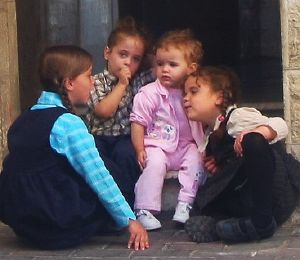Childhood
Childhood (being a child) is a broad term usually applied to the phase of development in humans between infancy and adulthood.



Definition
A child (plural: children) is a boy or girl who has not reached puberty, but also refers to offspring of any age. Adults remain the children of their parents, no matter what their age.
The legal definition of "child" is interchangeable with minor and may vary by country, in keeping with cultural conceptions.
The United Nations Convention on the Rights of the Child (1989), often referred to as CRC or UNCRC, an international convention setting out the civil, political, economic, social, and cultural rights of children, defines a child as "every human being below the age of eighteen years unless under the law applicable to the child, majority is attained earlier."
Attitudes toward children

Social attitudes toward children differ around the world, and these attitudes have changed over time. Modern views regard childhood as a most significant time, with renowned psychologists, including Sigmund Freud, arguing that the "formative" years (until around five or seven years of age) determine a person's life course to a very great extent. Others, such as John B. Watson and John Bowlby argued, from different theoretical stances, that the early months of an infant's life were critical. Concurrent with these academic views has been the greater awareness of children as in need of care, attention, and protection. This has been reflected in legislation mandating compulsory education, protection from exploitation through child labor, and against child abuse to name a few. But these developments are still recent; historically childhood was viewed differently.
In early times, children were viewed as property in many societies. Infanticide was common in most literate ancient cultures. The practice of infanticide has taken many forms, such as child sacrifice to supernatural figures or forces, as allegedly practiced in ancient Carthage. In some periods of Roman history, parents traditionally brought their newborn to the pater familias, the family patriarch, who would then decide whether the child was to be kept and raised or left to die by exposure. The Twelve Tables of Roman law obliged the pater familias to put to death a child with visible deformities. Female infants were especially vulnerable, as they were considered less valuable than boys who would be able to support the family whereas daughters would leave the family upon marriage, and in some cultures the dowry was an additional expense. Roman families often kept only one daughter (Breiner 1990). Although infanticide became a capital offense in Roman law in 374 C.E., offenders were rarely, if ever, prosecuted. Christianity, however, rejected the notion of infanticide from its earliest days. The Didache prescribed, "You shall not murder a child by abortion nor kill that which is born." The condemnation of infanticide spread with Christianity.
More than condemning infanticide, Christianity began to teach concern for children. In place of infanticide or abortion of unwanted children, the Church took them into convents or monasteries to be raised to serve the church. Religious writings began to glorify the innocence and purity of childhood. Within the medieval period, though, childhood was short and those as young as seven were expected to participate in household and community work, regarded simply as less experienced than adults. Philippe Ariès (1965), a French medievalist and historian, revealed through his study of [painting]]s, diaries, furniture, and school records that the conception of childhood as a distinct and important phase of life is a relatively modern one. Prior to the seventeenth century, children, once weaned and grown beyond infancy, were regarded as mini-adults. They were dressed as such, expected to participate in family activities, including work, along with the adults.
During the Renaissance, orphanages set up by charitable institutions began to emerge. This did not impact the social attitude to children much, however, and children continued to be expected to work.
The Protestant Reformation brought about a significant change in attitude to child-rearing. John Calvin, instead of regarding the child as innocent and pure, taught the doctrine of Original Sin and that even newborn infants are naturally inclined toward evil unless given the correct guidance and instruction (Pollock 1990). Thus, the Puritans took parenting very seriously, with manuals to aid parents and a focus on education.
The Victorian Era has been described as a source of the modern institution of childhood. Ironically, the Industrial Revolution during this era led to an increase in child labor. Due to the campaigning of the Evangelicals, and efforts of authors such as Charles Dickens, child labor was gradually reduced and halted in England via the Factory Acts of 1802-1878. The Victorians concomitantly emphasized the role of the family and the sanctity of the child, and broadly speaking, this attitude has remained dominant in Western societies since then.
Child development
Child development is the study of the processes and mechanisms that accompany the physical and psychological development of human beings as they mature from birth to adulthood. Since factors during pregnancy have been found to be significant in the development of an individual, the period from conception to birth may also be included in this field of study.
Most of the physical and mental development of a person takes place in childhood. In terms of physical development, early childhood is the time in which significant physical growth occurs, growth which depends on adequate nutrition and healthy physical exercise and environment. It is the critical period for establishing good habits of both exercise and nutrition which can last a lifetime. By the age of seven, nearly all of the motor control mechanisms in the brain are present and the child is rapidly developing motor skills. In preadolescence there are major growth spurts (usually experienced by girls between the ages of 9 and 12 years, and by boys between 11 and 14 years) muscles, tendons, and bones require reasonable exercise to develop well.
Psychological development is rather more complex. In fact psychologists have, since the beginning of psychology as an academic discipline, argued over the relative impact of inherited ("nature") characteristics versus the environment ("nurture") on a child's mental growth. Although early theorists put almost total emphasis on one or the other, Behaviorists following John Locke's environmentalist position that all knowledge is acquired through experience and learning while those like Arnold Gesell proposed that all development occurs naturally through maturation following Jean-Jacques Rousseau's Nativist conception of innate processes of development. Other issues include the idea of "recapitulation"—ontogeny repeats phylogeny—of Ernst Haeckel who proposed that the embryonal development of an individual organism (its ontogeny) followed the same path as the evolutionary history of its species (its phylogeny). This relates to the idea of stages of development, where development is seen as a discontinuous process involving distinct stages characterized by qualitative differences in behavior. Stage theories can be contrasted with continuous theories, which posit that development is a incremental process of growth (Vasta et al 1998).
The following list reflects the division of ages of child development commonly found in the twenty-first century. However, these age ranges are approximate, and may differ from culture to culture.
- Zygote, the point of conception, fertilization.
- Embryo; in the later stages also called fetus.
- Neonate (newborn) in the first month outside of the womb.
- Infant (baby) (ages 0–1.5).
- Toddler (ages 1.5–4).
- Middle childhood - Primary school/Elementary school age (ages 5–10).
- Prepubescence, a subset of the above (ages 10–11, approximately).
- Preadolescence (preteen, or middle school age) (ages 11–13, approximately). Note overlap with prepubescent stage of middle childhood.
- Adolescence and puberty (teenager) (13–19).
- Child abuse
- Child custody
- Child development
- Child labor
- Child prodigy
- Child sexual abuse
- Child support
- Childcare
- Education, School
- Educational psychology
- Parenting
- Pedophilia
- Pedagogy
- Pediatrics
- Play
ReferencesISBN links support NWE through referral fees
- Ariès, Philippe. 1965.Centuries of Childhood: A Social History of Family Life. New York: Vintage. ISBN 978-0394702865
- Boas, George. [1966] 1990. The Cult of Childhood. Spring Publications. ISBN 978-0882142180
- Brown, Marilyn R. (ed.). 2002. Picturing Children: Constructions of Childhood between Rousseau and Freud. Aldershot: Ashgate, 2002. ISBN 978-0754602774
- Buckingham, David. After the Death of Childhood: Growing Up in the Age of Electronic Media. Blackwell Publishers. ISBN 0745619339.
- Bunge, Marcia J. (ed.). 2001. The Child in Christian Thought. Grand Rapids, MI: William B. Eerdmans Publishing Co. ISBN 978-0802846938
- Calvert, Karin. 1994. Children in the House: The Material Culture of Early Childhood, 1600-1900. Boston, MA: Northeastern University Press. ISBN 978-1555531898
- Cleverley, John, and D. C. Phillips. 1986. Visions of Childhood: Influential Models from Locke to Spock. New York, NY: Teachers College. ISBN 978-0807728000
- Cunningham, Hugh. 2005. Children and Childhood in Western Society since 1500. London: Longman. ISBN 978-0582784536
- Cunnington, Phillis, and Anne Buck. 1965. Children’s Costume in England: 1300 to 1900. Adam & Charles Black.
- deMause, Lloyde (ed.). 1995. The History of Childhood. London: Jason Aronson. ISBN 978-1568215518
- Eckstein, M. A. 1967. The Darling Young The Record 69: 91-95. Retrieved October 7, 2008.
- Higonnet, Anne. 1998. Pictures of Innocence: The History and Crisis of Ideal Childhood. London: Thomas and Hudson Ltd. ISBN 978-0500280485
- Immel, Andrea, and Michael Witmore (eds.). 2005. Childhood and Children’s Books in Early Modern Europe, 1550-1800. New York, NY: Routledge. ISBN 978-0415972581
- Kincaid, James R. 1994. Child-Loving: The Erotic Child and Victorian Culture. New York, NY: Routledge. ISBN 978-0415910033
- Müller, Anja (ed.). 2006. Fashioning Childhood in the Eighteenth Century: Age and Identity. Burlington, VT: Ashgate. ISBN 978-0754655091
- O’Malley, Andrew. 2003. The Making of the Modern Child: Children’s Literature and Childhood in the Late Eighteenth Century. London: Routledge. ISBN 978-0415942997
- Pinchbeck, Ivy, and Margaret Hewitt. 1969. Children in English Society. 2 vols. London: Routledge.
- Pollock, Linda A. 1984. Forgotten Children: Parent-child relations from 1500 to 1900. Cambridge: Cambridge University Press. ISBN 978-0521271332
- Postman, Neil. 1994. The Disappearance of Childhood. New York, NY: Vintage.
- Shorter, Edward. 1977. The Making of the Modern Family. Basic Books. ISBN 978-0465097227
- Sommerville, C. John. 1992. The Discovery of Childhood in Puritan England. Athens, GA: University of Georgia Press. ISBN 978-0820313535
- Steinberg, Shirley R. and Joe L. Kincheloe. 2004. Kinderculture: The Corporate Construction of Childhood. Westview Press Inc. ISBN 081339157.
- Stone, Lawrence. 1983. The Family, Sex and Marriage in England 1500-1800. New York, NY: Harper and Row. ISBN 978-0061319792
- Zornado, Joseph L. 2006. Inventing the Child: Culture, Ideology, and the Story of Childhood. New York, NY: Routledge. ISBN 978-0415979665
- Office of the High Commissioner for Human Rights. 1989. Convention on the Rights of the Child United Nations. Retrieved January 17, 2008.
- Vasta, Ross, Marshall M. Haith, and Scott A. Miller. 1998. Child Psychology: The Modern Science. Third Edition. New York, NY: John Wiley. ISBN 047119221X
- Landsdown, Richard, and Marjorie Walker. 1991. Your Child's Development from Birth through Adolescence. New York, NY: Alfred A. Knopf. ISBN 0394578147
- Kotre, John and Elizabeth Hall. 1990. Seasons of Life: Our Dramatic Journey from Birth to Death. Boston, MA: Little, Brown & Company. ISBN 0316502529
- Konner, Melvin. 1991. Childhood. Boston, MA: Little, Brown & Company. ISBN 0316501840
- Marten, James. 2008. Childhood, Encyclopedia of American History. Answers Corp. Retrieved October 18, 2008.
- Kagan, Jerome. 1984. The Nature of the Child. New York, NY: Basic Books. ISBN 046504851X
- Breiner, Sander J. 1990. Slaughter of the Innocents: Child Abuse Through the Ages and Today. Plenum Publishing Corporation. ISBN 0306434598
- Pollock, Linda. 1990. A Lasting Relationship: Parents and Children Over Three Centuries. Lebanon, NH: University Press of New England. ISBN 0874515076
External links
All links Retrieved January 17, 2008.
- CDC's "Learn the Signs. Act Early.” campaign - Information for parents on early childhood development and developmental disabilities
- Historical children photos
- World Childhood Foundation
Credits
New World Encyclopedia writers and editors rewrote and completed the Wikipedia article in accordance with New World Encyclopedia standards. This article abides by terms of the Creative Commons CC-by-sa 3.0 License (CC-by-sa), which may be used and disseminated with proper attribution. Credit is due under the terms of this license that can reference both the New World Encyclopedia contributors and the selfless volunteer contributors of the Wikimedia Foundation. To cite this article click here for a list of acceptable citing formats.The history of earlier contributions by wikipedians is accessible to researchers here:
The history of this article since it was imported to New World Encyclopedia:
Note: Some restrictions may apply to use of individual images which are separately licensed.